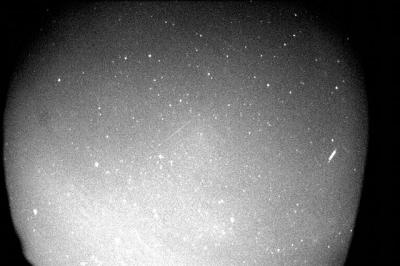Baltimore, MD - Jan. 3, 2024 - (PP) The Quadrantid meteor shower, the first shooting star show of 2024, could bring up to 120 meteors per hour to Maryland's skies this week. The peak of the Quadrantids is very brief, lasting only six hours, and this year it peaks at 7:53 a.m. Eastern Time on Thursday, January 4. To have the best chance of seeing shooting stars, observers should find a dark sky and start watching around 4:53 a.m.
However, the National Weather Service forecasts mostly cloudy skies in Maryland during that time. Despite the short peak, the Quadrantids are known for their high meteor rates and potential for bright fireballs. These meteors come from a thin debris stream that Earth crosses at a perpendicular angle.
The moon will be about half full during the shower's peak, so viewers are advised to block the moon with a tree or building and focus on the northern half of the sky. The Quadrantids offer the last opportunity to see a meteor shower until the Lyrid meteor shower in April.
The Quadrantids are named after the obsolete constellation Quadrans Muralis, and they originate from asteroid 2003 EH1, which has a unique orbit and may be a "dead comet" or "rock comet" left behind around 500 years ago.
Despite the brief peak and often poor January weather conditions, the Quadrantids have the potential to be one of the strongest meteor showers of the year, with around 25 shooting stars per hour visible under dark skies.

The moon will be about half full during the shower's peak, so viewers are advised to block the moon with a tree or building and focus on the northern half of the sky. The Quadrantids offer the last opportunity to see a meteor shower until the Lyrid meteor shower in April. (
Ladd ObservatoryCreative Commons Attribution-Share Alike 4.0)
Baltimore, MD - Jan. 3, 2024 - (PP) The Quadrantid meteor shower, the first shooting star show of 2024, could bring up to 120 meteors per hour to Maryland's skies this week. The peak of the Quadrantids is very brief, lasting only six hours, and this year it peaks at 7:53 a.m. Eastern Time on Thursday, January 4. To have the best chance of seeing shooting stars, observers should find a dark sky and start watching around 4:53 a.m.
However, the National Weather Service forecasts mostly cloudy skies in Maryland during that time. Despite the short peak, the Quadrantids are known for their high meteor rates and potential for bright fireballs. These meteors come from a thin debris stream that Earth crosses at a perpendicular angle.
The moon will be about half full during the shower's peak, so viewers are advised to block the moon with a tree or building and focus on the northern half of the sky. The Quadrantids offer the last opportunity to see a meteor shower until the Lyrid meteor shower in April.
The Quadrantids are named after the obsolete constellation Quadrans Muralis, and they originate from asteroid 2003 EH1, which has a unique orbit and may be a "dead comet" or "rock comet" left behind around 500 years ago.
Despite the brief peak and often poor January weather conditions, the Quadrantids have the potential to be one of the strongest meteor showers of the year, with around 25 shooting stars per hour visible under dark skies.
















